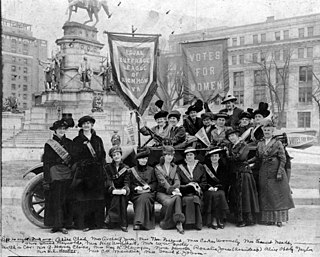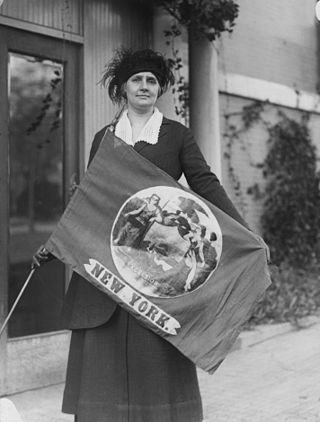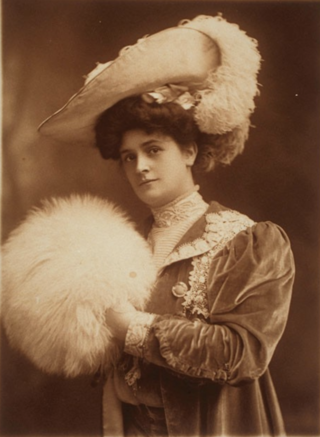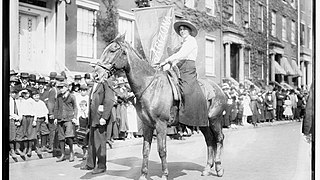Related Research Articles

The Nineteenth Amendment to the United States Constitution prohibits the United States and its states from denying the right to vote to citizens of the United States on the basis of sex, in effect recognizing the right of women to vote. The amendment was the culmination of a decades-long movement for women's suffrage in the United States, at both the state and national levels, and was part of the worldwide movement towards women's suffrage and part of the wider women's rights movement. The first women's suffrage amendment was introduced in Congress in 1878. However, a suffrage amendment did not pass the House of Representatives until May 21, 1919, which was quickly followed by the Senate, on June 4, 1919. It was then submitted to the states for ratification, achieving the requisite 36 ratifications to secure adoption, and thereby went into effect, on August 18, 1920. The Nineteenth Amendment's adoption was certified on August 26, 1920.

The National Society Daughters of the American Revolution is a lineage-based membership service organization for women who are directly descended from a patriot of the American Revolutionary War. A non-profit group, the organization promotes education and patriotism. Its membership is limited to direct lineal descendants of soldiers or others of the American Revolution era who aided the revolution and its subsequent war. Applicants must be at least 18 years of age and have a birth certificate indicating that their gender is female. DAR has over 190,000 current members in the United States and other countries. The organization's motto is "God, Home, and Country".

The National Woman's Party (NWP) was an American women's political organization formed in 1916 to fight for women's suffrage. After achieving this goal with the 1920 adoption of the Nineteenth Amendment to the United States Constitution, the NWP advocated for other issues including the Equal Rights Amendment. The most prominent leader of the National Woman's Party was Alice Paul, and its most notable event was the 1917–1919 Silent Sentinels vigil outside the gates of the White House.

Maud Wood Park was an American suffragist and women's rights activist.

Nina Evans Allender was an American artist, cartoonist, and women's rights activist. She studied art in the United States and Europe with William Merritt Chase and Robert Henri. Allender worked as an organizer, speaker, and campaigner for women's suffrage and was the "official cartoonist" for the National Woman's Party's publications, creating what became known as the "Allender Girl."
This timeline highlights milestones in women's suffrage in the United States, particularly the right of women to vote in elections at federal and state levels.

Women's suffrage was established in the United States on a full or partial basis by various towns, counties, states, and territories during the latter decades of the 19th century and early part of the 20th century. As women received the right to vote in some places, they began running for public office and gaining positions as school board members, county clerks, state legislators, judges, and, in the case of Jeannette Rankin, as a member of Congress.

The Minnesota Woman Suffrage Memorial is a permanent feature on the grounds of the Minnesota State Capitol in Saint Paul. It commemorates the women’s suffrage movement in the state and 25 women whose achievements were important to the Minnesota Woman Suffrage Association (MWSA). The memorial was designed by architects Raveevarn Choksombatchai, Martha McQuade, and Ralph Nelson.

The Dallas Equal Suffrage Association (DESA) was an organization formed in Dallas, Texas in 1913 to support the cause of women's suffrage in Texas. DESA was different from many other suffrage organizations in the United States in that it adopted a campaign which matched the social expectations of Dallas at the time. Members of DESA were very aware of the risk of having women's suffrage "dismissed as 'unladylike' and generally disreputable." DESA "took care to project an appropriate public image." Many members used their status as mothers in order to tie together the ideas of motherhood and suffrage in the minds of voters. The second president of DESA, Erwin Armstrong, also affirmed that women were not trying to be unfeminine, stating at an address at a 1914 Suffrage convention that "women are in no way trying to usurp the powers of men, or by any means striving to wrench from man the divine right to rule." The organization also helped smaller, nearby towns to create their own suffrage campaigns. DESA was primarily committed to securing the vote for white women, deliberately ignoring African American women in the process. Their defense of ignoring black voters was justified by having a policy of working towards "only one social reform at a time."

The Texas Equal Suffrage Association (TESA) was an organization founded in 1903 to support white women's suffrage in Texas. It was originally formed under the name of the Texas Woman Suffrage Association (TWSA) and later renamed in 1916. TESA did allow men to join. TESA did not allow black women as members, because at the time to do so would have been "political suicide." The El Paso Colored Woman's Club applied for TESA membership in 1918, but the issue was deflected and ended up going nowhere. TESA focused most of their efforts on securing the passage of the federal amendment for women's right to vote. The organization also became the state chapter of the National American Woman Suffrage Association (NAWSA). After women earned the right to vote, TESA reformed as the Texas League of Women Voters.

The Equal Suffrage League of Virginia was founded in 1909 in Richmond, Virginia. Like many similar organizations in other states, the league's goal was to secure voting rights for women. When the 19th Amendment to the U.S. Constitution was ratified in 1920, enabling women to vote in all states, the Equal Suffrage League dissolved and was reconstituted as Virginia League of Women Voters, associated with the national League of Women Voters. The 19th Amendment was not ratified in Virginia until 1952.

Edith M. Ainge (1873–1948) was an American suffragist and a member of the activist group the Silent Sentinels. Ainge joined the National Woman's Party (NWP) led by Alice Paul to advocate for women's right to vote in the United States, which was established with the ratification of the 19th amendment in 1920. Ainge was arrested approximately five times from September 1917 to January 1919 for "unlawful assembly" at NWP protests, and she later served as treasurer of the NWP.

Harriet Wright Laidlaw was an American social reformer and suffragist. She campaigned in support of the Nineteenth Amendment and the United Nations, and was the first female corporate director of Standard & Poor's.

Women's suffrage was granted in Virginia in 1920, with the ratification of the Nineteenth Amendment to the United States Constitution. The General Assembly, Virginia's governing legislative body, did not ratify the Nineteenth Amendment until 1952. The argument for women's suffrage in Virginia began in 1870, but it did not gain traction until 1909 with the founding of the Equal Suffrage League of Virginia. Between 1912 and 1916, Virginia's suffragists would bring the issue of women's voting rights to the floor of the General Assembly three times, petitioning for an amendment to the state constitution giving women the right to vote; they were defeated each time. During this period, the Equal Suffrage League of Virginia and its fellow Virginia suffragists fought against a strong anti-suffragist movement that tapped into conservative, post-Civil War values on the role of women, as well as racial fears. After achieving suffrage in August 1920, over 13,000 women registered within one month to vote for the first time in the 1920 United States presidential election.

Maude E. Craig Sampson Williams was an American suffragist, teacher, civil rights leader, and community activist in El Paso, Texas. In June 1918, she formed the El Paso Negro Woman's Civic and Equal Franchise League and requested membership in the National American Woman Suffrage Association (NAWSA) through the Texas Equal Suffrage Association (TESA), but was denied. Williams organized African-American women to register and vote in the Texas Democratic Party primary in July 1918. She was one of the founders and a charter member of the El Paso chapter of the NAACP, which was the first chapter in the state of Texas. Williams served as the vice president of the El Paso chapter from 1917 to 1924 and remained active in the NAACP until her death. Williams played a significant role in the desegregation of Texas Western College in 1955, which was the first undergraduate college in Texas to be desegregated by a court order other than that of the Supreme Court of the United States. Midwestern University (now known as Midwestern State University was previously ordered to desegregate in 1954 by the SCOTUS immediately following the Brown v. Board of Education ruling.

The movement for women's suffrage in Arizona began in the late 1800s. After women's suffrage was narrowly voted down at the 1891 Arizona Constitutional Convention, prominent suffragettes such as Josephine Brawley Hughes and Laura M. Johns formed the Arizona Suffrage Association and began touring the state campaigning for women's right to vote. Momentum built throughout the decade, and after a strenuous campaign in 1903, a woman's suffrage bill passed both houses of the legislature but was ultimately vetoed by Governor Alexander Oswald Brodie.
References
- ↑ Benhuri, Ariana (2023). "Biographical Database of NAWSA Suffragists, 1890–1920: Biography of Ida Reid (Mrs. John) Blair, 1874 –1930". alexanderstreet.com. Retrieved 2 Nov 2023.
Includes many useful references
- 1 2 3 4 5 6 7 8 9 10 11 12 13 Binheim, Max; Elvin, Charles A. (1928). Women of the West: A Series of Biographical Sketches of Living Eminent Women in the Eleven Western States of the United States of America. Los Angeles: Publishers Press. Retrieved August 6, 2017.
 This article incorporates text from this source, which is in the public domain .
This article incorporates text from this source, which is in the public domain . - ↑ Michals, Debra (2015). "Shirley Chisholm". National Women's History Museum. Retrieved October 5, 2022.
Ever aware of racial and gender inequality, she joined local chapters of the League of Women Voters, the National Association for the Advancement of Colored People (NAACP), the Urban League, as well as the Democratic Party club in Bedford-Stuyvesant, Brooklyn.
- ↑ "Dorothy Douglas, Hofstra Professor". The New York Times. New York. 11 Dec 1968. Retrieved 2 Nov 2023.
- ↑ Feld, Rose C. (13 June 1937). "Child Labor in this Country". The New York Times. New York. Retrieved 2 Nov 2023.
- ↑ "Eliza Douglas". Lilith. Lilith Publications, Inc. 21 June 2018. Retrieved 2 Nov 2023.
- ↑ Alterman, Eric (23 May 2013). "Remembering the 'Feminine Mystique'". AmericanProgress. Center for American Progress. Retrieved 2 Nov 2023.
- ↑ "But One Woman Seeks Election to Legislature". Oakland Tribune: 18. August 29, 1926. Retrieved 24 September 2017.
- ↑ Sampson, Ovotta (July 3, 1998). "Local woman takes helm of national voters league". newspaperarchive.com. pp. , . Retrieved 2022-04-14.
- ↑ Palmer, Beverly Wilson; Sklar, Kathryn Kish, eds. (2009). The Selected Letters of Florence Kelley, 1869–1931. United States: University of Illinois Press. ISBN 9780252034046.
- ↑ Lumpkin, Katherine Du Pre (February 1992). The Making of a Southerner. Greece: The University of Georgia Press. ISBN 9780820313856.
- ↑ * Jane Y. McCallum. "Texas Originals". Humanities Texas. Retrieved 13 September 2017.
- ↑ Brereton, Bridget (4 January 2012). "Lenora: activist for women in politics". Port of Spain, Trinidad: Trinidad Express Newspapers. Archived from the original on 6 March 2012. Retrieved 21 October 2017.
- ↑ "Edith Dolan Riley papers 1965" . Retrieved 3 October 2017.
- ↑ "FamilySearch: Edith Rose Dolan". FamilySearch. The Church of Jesus Christ of Latter-day Saints. 2 Nov 2023. Retrieved 2 Nov 2021.
She died on 2 February 1967, in Boise, Ada, Idaho, United States, at the age of 81, and was buried in Boise, Ada, Idaho, United States.
- ↑ "Mrs. Roan and Atlanta Delegates Attend Women Voters' Convention". The Atlanta Constitution. 1938-04-25. p. 11. Retrieved 2021-03-23– via Newspapers.com.
- ↑ Eleanor Roosevelt Papers Project. "Eleanor Roosevelt and Women's Rights". National Park Service. U. S. Department of the Interior. Retrieved October 5, 2022.
after the 1920 presidential election, Roosevelt became a board member of the New York State League of Women Voters and began to direct the League of Women Voters' national-legislation committee.
- ↑ "League Studies Recession" Pittsburgh Press (March 27, 1958): 24. via Newspapers.com

- ↑ "Home About Us Leadership & Staff Virginia Kase Solomón". lwv.org. The League of Women Voters. 2022. Retrieved 2 Nov 2023.
- ↑ "Virginia Case". InfluenceWatch. Capital Research Center. 2023. Retrieved 2 Nov 2023.
- ↑ Virginia Kase Solomón Named Tenth President of Common Cause, Common Cause (December 14, 2023).
- ↑ Fairchild, Erika S. (1986). "Gardner, Fay Webb". NCPEDIA. Retrieved 30 November 2021.
This article needs additional or more specific categories .(July 2024) |